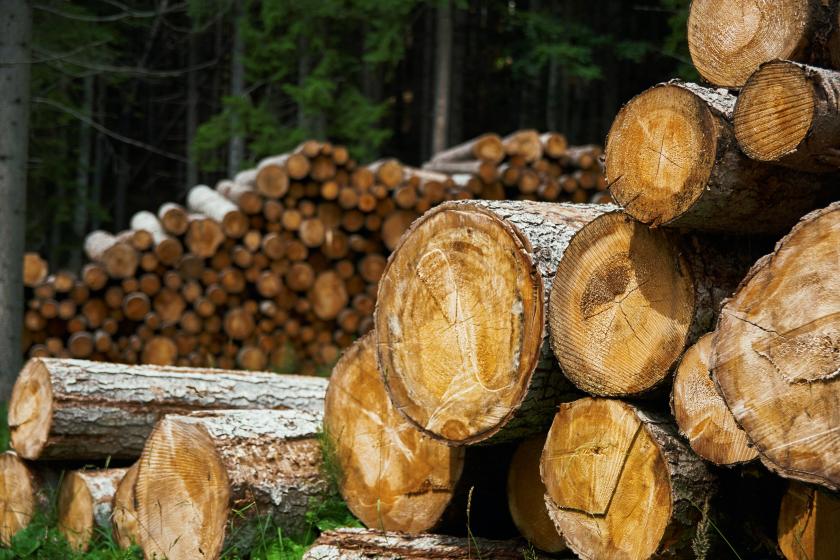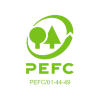LegalSource certification helps you to meet market demands for legal timber assurance and legal requirements such as the EU Timber Regulation (EUTR).
If you are based in a timber exporting country, LegalSource certification helps you provide the assurance sought by buyers in regions where strict timber regulations apply.
LegalSource Trademark
As a LegalSourceTM certificate holder, you have earned access to the LegalSource label and claims. These visual markers create instant recognition for your commitment to legal timber sourcing.
The LegalSource trademarks use
The name LegalSource is a registered trademark owned by Preferred by Nature. As a LegalSource certificate holder, you may use this trademark in promotional claims and statements, providing you comply with our trademark requirements.
You may also use the LegalSource Certified claim and label to promote products covered by your certificate or to underpin your organisation's commitment to legal timber sourcing.
Note: The LegalSource trademark is not eligible for on-product use.
Conditions for using the LegalSource trademarks
As a LegalSource certificate holder, you need to follow the LegalSource trademark requirements which cover graphic design and credible claims. These are set out in the LegalSource Claims & Communications Procedure.
Note: You need to submit materials including LegalSource trademarks to us for approval prior to any public use.
Three top benefits of LegalSource certification
Effective risk management. Our auditing helps you detect gaps and effectively manage the risk of illegal timber entering into your supply chain.
Legal compliance. The certification process helps you identify and address weaknesses of your systems in terms of legal compliance if you are obliged by the EUTR, the US Lacey Act or the Australian Illegal Logging Prohibition Act.
Enhanced market access. Assurance of legal origin is often a basic requirement for timber products. Certification provides access to the LegalSource claims and labels and helps you demonstrate your efforts to source legal timber. This helps you to stay strong in key markets.
EUTR Monitoring Services
Choose a safe route to due diligence and ensure that you are complying with the EU Timber Regulation (EUTR).
- Preferred by Nature is recognised by the European Commission as a Monitoring Organisation (MO) to assist EU operators in meeting their EUTR obligations.
- We are also endorsed by the European Free Trade Association (EFTA) Surveillance Authority as the EUTR MO in Iceland, Norway and Liechtenstein.
- MOs do this by providing an EUTR-compliant due diligence system and conducting regular evaluations of the operators' due diligence performance.
Key steps
To receive a price offer contact us.
> Find contact information for MO service enquiries in each EU member state
The core service consists in regular evaluations which we conduct as LegalSource audits. This is why the steps outlined below are similar to the LegalSource certification process.
Step 1: Service scope
We help you clarify the scope of monitoring services you need. The minimum scope of your LegalSource certificate includes all trade that is covered by the EUTR. Once you have accepted our offer, we assign a Preferred by Nature contact person for your organisation.
Step 2: Your preparation
You receive an information pack with resources and tools to help you prepare for certification. You set up and implement the free LegalSource Due Diligence System (DDS). If you opt for training, we will equip you with know-how for implementing the DDS at this stage.
Step 3: On-site audit
We conduct an on-site visit at your facilities to verify your conformance with the LegalSource Standard. This includes a tour of your facilities, document reviews and staff interviews. The duration of the visit depends on your set-up and certification scope.
Step 4: Report
We prepare an evaluation report describing the strengths and weaknesses of your system. It includes structured feedback enabling you to identify and address any EUTR compliance issues. See LegalSource public summary reports here.
Step 5: Certification
Providing the evaluation outcome is positive, we issue a LegalSource certificate. The certificate demonstrates that your due diligence performance has been independently verified and found to be in conformance with the EUTR requirements.
Maintaining your certificate
Once you have achieved certification, you need to undergo annual LegalSource audits verifying your continued compliance. This fulfils the EUTR requirements for regular evaluation and helps you ensure that you are on track with meeting your due diligence obligations. Additional audits are only required in special cases.
Note: EU-recognised MOs are obliged to report significant or repeated failures to properly implement the due diligence system to the local Competent Authority.
Service scope and conditions
The scope of your service will be clarified during our initial dialogue. The following conditions apply in all cases:
You must implement the LegalSource Due Diligence System. Our EUTR-compliant system is available for free. As our EUTR monitoring client you are required to use this system as the framework for your own due diligence procedures; however, you may adapt it to suit your reality providing it remains EUTR compliant.
We perform the regular due diligence evaluations as certification audits. As such, you will earn LegalSource certification and access to the LegalSource claims and off-product logo. The scope of your certificate at minimum needs to include all products and supply chains that are covered by the EUTR.
Complementary services
The following services can complement the core MO service as and when you find this helpful.
- Training can help you tackle initial challenges and prevent human error when implementing the LegalSource Due Diligence System. Consider engaging in our one-day LegalSource Kickstarter Course where participants receive step-by-step instruction on how to use the system's tools and templates. We can also organise customised training or workshops.
- On-going support provides access to a LegalSource expert in between the scheduled audits. Your designated expert will be available to assist you whenever you have questions related to the EUTR, for example if you have doubts about the requirements for risk assessment and mitigation.
- Supplier auditing in some cases may be the best option or even required to mitigate risk. We can offer to conduct supplier audits on your behalf, however this is not mandatory. If supplier audits are required you can choose to conduct supplier audits yourself, in which case we will only carry out sample checks to verify the quality of your audits.
Three benefits of using an EU-recognised MO
Trust. MOs have been carefully evaluated by the European Commission and found competent to deliver an adequate due diligence system and related monitoring services. You do not need to double-check their expertise or the validity and functionality of the system they offer.
System provision. EU Operators are obliged to establish and maintain a due diligence system covering all the EUTR requirements. Instead of inventing your own system, you use the MO’s approved system.
Assurance. You will gain enhanced certainty that your due diligence performance meets the EU requirements. Because MO experts know the ins and outs of the EUTR, you can expect to gain qualified feedback.
Note: The main benefit of engaging with an MO is the expert help you gain in navigating the EU requirements. Working with an MO does not exempt you from liability under the EUTR.
Due diligence support
Ensure that you're on track to implement a robust due diligence system for legal timber trade. We can assist you to seal any gaps and meet your own sourcing policy or legal obligations.
We can support you throughout your due diligence process, regardless of your level of expertise. For instance, we can help if you:
- Need to get to grips with the EUTR due diligence requirements.
- Need expert support to establish due diligence systems, conduct risk assessments or define appropriate risk mitigation measures.
- Would like to assess your due diligence system against your own sourcing policy or against specific timber regulations.
- Need to evaluate your suppliers' ability to meet your requirements and identify potential gaps.
- Seek advice or training on specific aspects of due diligence, such as risk assessment or mitigation.
Select services
Choose from a string of services within the following broad areas to support you with your due diligence process. Your situation, context and needs define how the services are tailored and combined.
LegalSource Gap Analysis: This streamlined service quickly identifies gaps or weaknesses in your current systems compared to timber market regulations or your policies. Benchmark your due diligence system and performance against our LegalSource Standard and potentially your own criteria. You receive the results in a user-friendly format, including a set of recommendations for targeted action.
Generic Chain of Custody (CoC) Certification: Have your system to physically separate certain material categories verified to demonstrate its robustness. Companies successfully evaluated against NEPCon generic CoC standard will earn a certificate, enabling them to trade the products covered by the certificate with corresponding claim category.
> Download fact sheet on our CoC certification services
Training & information: Receive tailored information or engage in due diligence training and workshops to build your in-house capacity. We recommend joining one of our standard training courses which are designed to equip companies with due diligence competencies:
- LegalSource Intro Course: Typically lasting half a day, this course provides essential know-how on timber regulations and due diligence within a short space of time.
- LegalSource Kickstarter Course: This one-day course puts due diligence in practice. This course is targeted for companies wishing to implement the free LegalSource Due Diligence System or adapt the LegalSource tools for their own system.
- LegalSource Expert Course: This international three-day course equips delegates with comprehensive understanding of due diligence in theory and in practice. It also provides formal LegalSource credentials for those who pass the exam.
Supplier evaluation & training
We can verify the readiness of your suppliers to provide access to information and evaluate their conformance with your due diligence requirements, identifying any gaps. We can also evaluate the effectiveness of your suppliers' risk mitigation actions. This can be complemented with training of your suppliers.
Learn more about LegalSource supplier evaluation
On-going support
Ensure consistent and effective implementation of your due diligence system across your company and supply chains. We offer advisory services and evaluations that identify strengths and weaknesses in your current practices. This helps you define appropriate actions to address any gaps.
Note: These services form an excellent basis for moving on to LegalSource certification. If you are obligated by the EUTR, you may also consider engaging with us for EU-recognised monitoring services.
Three benefits of using expert assistance
Reassurance. Based on evaluations, tools and advice from experts with in-depth knowledge in timber legality, you can be confident that your risk assessments and mitigating actions are adequate. You will know which steps you need to take in order to tackle due diligence requirements and seal any gaps in your system.
Efficiency. Our services are based on solid expertise and robust systems, and we provide tools and information as and when you need them. This saves you time perusing regulations and inventing systems, tools and procedures.
Confidence amongst buyers and investors. Teaming up with reputable experts, you send a strong signal about the quality of your efforts and your commitment to legal timber trade.
Supply chain support
Evaluation of your suppliers helps you to assess and address the risk of illegal timber in your supply chains.
Supplier evaluation permits you to assess and control the risk that your suppliers' products contains illegal timber. The evaluation process facilitates good communication with your supplier around these issues. It also builds your suppliers' competencies, enabling them to better support your due diligence efforts.
When is supplier evaluation needed?
You may need supplier auditing if you are sourcing from countries with high risk of illegal harvesting and high corruption levels. In such regions, it is risky to rely on official documents alone, unless the products are verified under a credible scheme.
Key steps
We are happy to offer a non-binding quote for conducting supplier audits on your behalf. You can receive a free non-binding service quote by filling in our service request form or by contacting us. Before you decide to engage on supplier verification, you may need to go through these steps:
1. Determine if you need supplier evaluation. On-site supplier verification is effective in identifying and addressing risks of sourcing illegal timber, but can be labour intensive and normally involves transportation costs. Before you engage on supplier verification, we recommend you to first explore if there are other, more cost-effective ways of obtaining the assurance you need.
2. Decide if you need external assistance. You may want to conduct on-site supplier evaluation yourself, which is perfectly legitimate. Your capacity and the complexity of the task are important factors in determining the best approach. If you wish to set up an in-house auditing function, we can provide capacity building for your appointed legality auditors.
The service process
If you choose to engage with us for supplier evaluation, the process will normally run as follows:
Step 1: Service scope: You define the scope of the evaluation including suppliers and products to be covered. You enter a formal agreement with suppliers included in the scope, permitting us to conduct the evaluation.
Step 2: Your suppliers' preparation: At your request, we can assist in communicating with your suppliers about the process and coordinate directly with them around the audit schedule. We can also provide online training for your suppliers in advance of the evaluation.
Step 3: Evaluation: The evaluation includes interviews, document reviews and on-site inspection. Supplier evaluations are normally carried out on-site. However, in certain cases desk evaluation may be sufficient depending on the type of risk involved.
Step 4: Report: We provide initial oral feedback to you and your supplier. We then prepare a report describing our findings. The report covers any identified non-conformities or gaps and includes recommendations for follow-up actions.
Choose service level and scope
The scope of the supplier evaluation is entirely determined by your needs. Depending on your suppliers' role in securing your due diligence, the evaluation may cover aspects such as:
- Your suppliers' access to required information.
- Your suppliers' conformance with your due diligence requirements.
- The quality of risk assessments carried out by your suppliers.
- The effectiveness of your suppliers' risk mitigating actions.
Your choice of types and number of products to be covered will often depend on your trade conditions. For example, you may want to limit the scope to products that are covered by the EUTR.
With our established global network of experts, we can cover any number of suppliers and supply chains in most regions of the world.
If you are engaging with us for LegalSource evaluation or certification of your own organisation, we will normally agree on the scope of any supplier verification services during audits conducted on your premises.
Opportunity for capacity building
We recommend combining supplier evaluation with targeted training. This enables your suppliers to take an active role in supporting your due diligence process.
We can provide online training prior to or after the on-site visit. Alternatively we can deliver face-to-face training during the visit.
Five benefits of engaging in third-party supplier evaluation
Depending on the evaluation's purpose and scope, supplier evaluation may bring the following benefits:
Improved efficiency. By enlisting a competent expert, you save in-house resources whilst being sure to receive a qualified output.
In-house capacity. Your own quality control staff or internal auditors will learn from the evaluation process. This facilitates you to integrate due diligence requirements in your own supplier evaluation programme.
Evaluation of your suppliers' access to information. More often than not, your suppliers are key to ensuring you have access to information as required by the EUTR.
Evaluation of your suppliers' conformance with your due diligence requirements. We evaluate the validity and comprehensiveness of the information and documentation presented by your suppliers. This helps you to identify gaps in information or documentation that constitute risk, and provides a good basis for communicating with your suppliers about the actions that they need to take.
Enhanced supplier relations. Supplier evaluation forms an excellent basis for creating a road map to safe sourcing even from suppliers based in high-risk areas or dealing in high-risk products. It helps you to make informed decisions on risk levels, identify appropriate risk mitigation measures, and ultimately build stronger relations with suppliers who are able and willing to collaborate with you around due diligence.
LegalSource timber testing
Timber testing is a reliable way of obtaining evidence regarding the origin and species content of timber products. Scientific techniques are increasingly used to reveal which species a product contains and where the wood originates from.
Timber testing helps you to meet legal obligations related to information and risk management. You can include regular timber testing as a part of your due diligence programme or have high-risk products tested on a one-off basis.
Select service level
We offer two levels of service. You can always change level whenever your needs change:
1. Our basic service offering helps you identify the appropriate type of test to answer your due diligence questions and the relevant laboratory to use.
2. Our full service encompasses enhanced support to collect suitable samples, arrangement of the testing with our network of laboratories and interpretation of the results of testing within your wider due diligence system, as well as relevant next steps.
Choose testing technique
We work with three main types of timber testing. Each methodology provides a different type and level of evidence. The best choice of technique depends on the due diligence question which needs to be answered. The feasibility of using certain techniques may also depend on the availability of reference data for the species of origin. Below is an overview of the techniques and the types of information they can provide:
Wood Anatomy analysis: Macroscopic or microscopic analysis can be used to identify species or groups of species. This is a relatively fast and less expensive timber testing method, and it may in many cases suffice to answer your due diligence question.
DNA testing: This is a precise technique for identifying timber species contained in a timber product. DNA testing can distinguish even between closely related species, In some cases it can help to identify origin, too.
Stable Isotope analysis: This methodology effectively identifies the geographic origin of timber. However, it does not offer any information regarding timber species.
Three benefits of LegalSource Timber Testing
Objective and reliable evidence. Analyses based on reliable techniques and provided by well-reputed laboratories provide you with proof to back up claims for your products. You will receive a scientific analysis report that you can forward to your buyers.
Effective due diligence. Using timber testing as a part of your due diligence process reduces your risk of being in non-compliance with the EUTR and similar legislation. You can use it on a case-by-case basis or for regular sampling.
Cost-effective supply chain management. In some cases, timber testing can reduce or eliminate the need for on-site supplier verification.
Complaints & resolutions
Find statements and resolutions regarding complaints raised about our LegalSource clients or certification services.
If a complaint is raised about our certification services or one of our clients, we handle this in accordance with our Dispute Resolution Policy. We may call on our Impartiality Committee if Preferred by Nature´s impartiality is under question.
Review Preferred by Nature LegalSource certified companies here.
Timber regulations
Get to grips with the EUTR
The EU Timber Regulation affects thousands of EU operators and their supply chains. This page provides information and tips to help you navigate the requirements.
The purpose of the EU Timber Regulation (EUTR) is to halt the trade of illegal timber into the EU. The regulation is an important element of the EU FLEGT (Forest Law Enforcement, Governance and Trade) Programme.
The EUTR came into force on 3 March 2013. Due to the size of the EU timber market, this regulation affects timber products trade globally.
Whilst the onus is on the thousands of EU operators to which the EUTR directly applies, the regulation also impacts suppliers and traders worldwide whose products may ultimately arrive on the EU market.
EUTR basics: The EU Timber Regulation includes three key requirements:
- Ban on illegally harvested timber: The regulation prohibits the placing of illegally harvested timber or timber products on the EU market for the first time. The ban applies to numerous products listed in the regulation’s annex. See which products are listed.
- Obligation to register trade partners: All EU traders of listed products are required to keep records of their buyers and suppliers.
- Due diligence obligations: The EUTR requires “operators” – EU companies placing any of the listed products on the EU market for the first time – to exercise “due diligence” in order to minimise the risk of illegal timber entering into the European Union.
What is due diligence?
Operators that are obliged to exercise due diligence need to set up a due diligence system covering the following core aspects:
- Access to information about the products and supply chains. This includes product description; quantity, timber species, country or if applicable sub-national area of harvest, indicators of legal compliance and name and address of buyers and suppliers.
- Risk assessment evaluating the risk of illegal timber entering into their supply chain. The risk assessment must cover all applicable products and supply chains.
- Risk mitigation serves to reduce any risk identified, for example by requiring additional documentation or supplier verification.
- Regular evaluations of the operator's due diligence system and performance.
Quick guidance for EU buyers and non-EU suppliers
Are you seeking to meet legal obligations or buyers' demands arising from the EUTR? It can be difficult to know where to begin. Use the tabs below to find a brief description of the key steps involved as well as a collection of links and resources to guide you further.
EU companies: key steps for EU-based companies
Numerous product types are covered, but many are not. See which products are covered Determine if your company is an “operator” or “trader”. You are a “trader” if you: |  | A: My products are not listed B: My products are listed |
2. Buy or sell material that has already been placed on the EU market. You are an “operator” if you: a) harvest timber from a forest located within the EU and place it on the EU market or use it through your own business; b) place or cause any product covered by the regulation to be placed on the EU market, either for onward sale or for your own commercial purposes. |
| A: I am a “trader” Your only obligation is to register buyers and suppliers of EUTR-listed products.
B: I am an “operator” Like traders, you need to register buyers and suppliers of EUTR-listed products. In addition, you need to fulfil the full set of EUTR due diligence requirements, and take the next steps listed below. Proceed to Step 3. |
Note: The following steps are only relevant for operators!
- Set up your due diligence system. This entails developing written due diligence procedures, defining responsibilities, and ensuring competence.
- Compile information about your products and supply chain. You need to fulfil specific requirements for access to information. And you need adequate information to be able to make any positive conclusions about the risk of illegal harvesting contained in your products.
- Conduct risk assessment. For each product and supplier, you need to conclude whether the risk is “negligible” or “non-negligible”. Conclusions will often be based on the picture that emerges from considering several aspects, such as certification status and the level of corruption in the country of origin. However, certain aspects may lead to immediate conclusions about the risk. Any outstanding information gap that does not permit a firm conclusion implies that there is non-negligible risk.
- Mitigate identified risk. For ‘non-negligible’ risk, you need to implement risk mitigating actions. The appropriateness of a risk mitigating action depends entirely on the type of risk and may range from acquiring further documentation to conducting on-site supplier verification or replacing suppliers.
- Set up a system for performance evaluation: the EUTR requires you to regularly evaluate your system's effectiveness in excluding illegally harvested timber from your supplies.
Note: The following steps are only relevant for operators!
Suppliers to the EU Market
Key steps for supply chain companies located outside of the EU
Although you are not directly obliged to observe the EUTR, your trade is likely to be affected if your products are ultimately destined for the EU market. Here are some tips on steps that you can take to help you navigate the new conditions within your trade.
Collect information. Actively seek information about the risk of illegal logging in the areas where your products are harvested.
Assess the quality and comprehensiveness of the information you have gathered. Determine what type of additional information/documentation that you need to further assess and mitigate any perceived risk.
Identify and document origin and timber species. EU buyers must have access to reliable information about the timber species occurring in each product. For each species, the country of origin — in some cases even the forest of origin — must be known. You will need to work with your suppliers to obtain this information.
Document legal harvesting. Legal harvesting entails compliance with all legislation applying to timber harvesting, such as logging permits, harvest regulations, environmental laws and payment of fees and taxes. Work with your suppliers to provide reliable documentation for legal harvesting. Implement timber tracking systems to ensure traceability, unless your products are already covered by a verification scheme offering this. This enables you to offer assurance for the origin of your products.
Engage in a credible timber certification or verification scheme. Credible third-party verification of legal harvesting assurance will satisfy many buyers further down the supply chain.
Encourage your suppliers to obtain certification or verification according to a credible scheme. Or select suppliers who are already certified.
Resources
Download:
- Official EUTR information from the EU
The authoritative webpage on the EUTR. It includes concise information, updates, news, links to the EUTR itself and guidance documents. It also provides a list of EU-recognised Monitoring Organisations as well as links to national Competent Authorities overseeing the EUTR enforcement. - Chatham House illegal logging website
A comprehensive site with news and updates focusing on illegal timber harvesting worldwide. - European Timber Trade Federation (ETTF)
The website includes a news feed with regular updates on timber legality issues. - European Forest Institute Portal
A comprehensive site with news and updates on the EU’s Forest Law Enforcement, Governance and Trade (FLEGT) Action Plan. - Sourcing Hub
The Hub contains assessments of the risks of illegal timber production and trade in more than 65 countries. - Transparency International
Transparency International publishes the annual Corruption Perception Index (CPI) indicating the level of corruption in most countries of the world. - WWF Global Forest and Trade Network (GFTN)
This WWF website offers guidelines for sourcing of legal and sustainable wood. - Forest Legality Alliance
A website with useful resources on legal timber sourcing.
EUTR: which products are covered?
Barrels, wooden panels and most furniture items are covered by the EUTR. Brooms, clothes hangers and pencils are not. Do you know if the EUTR applies to your products?
Read on to find out if your timber or paper products are covered by the EUTR.
How to decide if your products are covered
To help you determine whether or not your product is covered by the EUTR, we have compiled lists below. They help you gain a quick overview of products that are covered and exempt.
- Products covered by the regulation
Products that are exempt
Note: Products which are currently exempt from the regulation may become covered in the future.
You may want to double-check with the official sources of information. The easiest way of doing this is to follow these steps:
- Determine where your product belongs in the EU Combined Nomenclature.
- Check directly with the annex of the EUTR. If the relevant product class is included, then your product is covered by the Regulation.
Beware of important distinctions
Some product types/materials are only partially covered by the EUTR or they are only covered in certain circumstances. Below is a summary of areas where it is important to be clear on the exact distinctions and definitions used in the EUTR and the EU Combined Nomenclature.
Packaging
The EUTR covers "packing cases, boxes, crates, drums and similar packing, of wood; cable-drums of wood; pallets, box pallets and other load boards, of wood; pallet collars of wood". Essentially, this includes almost any wood-based packing material or transportation aids used to convey other products.
However, the EUTR only applies to packing material when a) it is sold as a product in its own right, or b) when the packaging gives the product its essential character, such as decorative gift boxes.
The EUTR does not apply to packaging which is "used exclusively as packing material to support, protect or carry another product placed on the market". For example, if you purchase products delivered within cardboard boxes or on pallets, then the packaging material normally isn't covered.
The Regulation also exempts packaging which is "specially shaped or fitted to contain a specific article or set of articles, suitable for long-term use and presented with the articles for which they are intended". Examples include camera cases, musical instrument cases, gun cases, and necklace cases.
Note: The customs clearance is important in determining which product is "placed on the EU market". If a material is customs cleared as packaging, then it is covered by the EUTR. But if you import a product X which is customs cleared as "X", then the packaging holding X is exempt.
Recovered/ waste products
Timber products are exempt from the Regulation if it can be documented that they are produced "from timber or timber products that have completed their lifecycle and would otherwise be disposed of as waste, as defined in Article 3(1) of Directive 2008/98/EC of the European Parliament and of the Council of 19 November 2008 on waste. One example is timber material deriving from the demolition of buildings located outside of the EU.
Printed matter
Books, brochures, and photos are exempt from the Regulation. This applies to any printed matter where the print itself constitutes the essential product.
However, other types of paper or tissue are covered although they may carry print . Examples include facial tissue, toilet paper, packaging or stationery paper.
Bamboo products
Bamboo-baskets.jpg Products made from solid bamboo, such as bamboo flooring, bamboo table tops and furniture parts are covered by the EUTR. However, the following product types are exempt:
- Products made from plaited or woven bamboo.
- Pulp and paper made from bamboo.
- Seats (chairs, sofas, etc.) made from bamboo.
Furniture
Most furniture is covered by the EUTR. However, the following product groups are exempt:
1. Seats including sofas, chairs, etc.
2. Furniture made from plaited/weaved bamboo.
3. Medical, surgical, dental or veterinary furniture.
Products covered by the EUTR
This list has been created to help you gain an overview of the products that are covered by the EU Timber Regulation (EUTR). It draws on information in the Annex of the EU Timber Regulation.
The four letter codes refer to the Combined Nomenclature for timber and timber products set out in Annex I of the Council Regulation (EEC) No 2658/87.
List of products covered by the EUTR
- Fuel wood, in logs, in billets, in twigs, in faggots or in similar forms; wood in chips or particles; sawdust and wood waste and scrap, whether or not agglomerated in logs, briquettes, pellets or similar forms (4401).
- Wood in the rough, whether or not stripped of bark or sapwood, or roughly squared (4403).
Railway or tramway sleepers (cross-ties) of wood (4406). - Wood sawn or chipped lengthwise, sliced or peeled, whether or not planed, sanded or end-jointed, of a thickness exceeding 6 mm (4407).
- Sheets for veneering (including those obtained by slicing laminated wood), for plywood or for other similar laminated wood and other wood, sawn lengthwise, sliced or peeled, whether or not planed, sanded, spliced or end-jointed, of a thickness not exceeding 6 mm (4408).
- Wood (including strips and friezes for parquet flooring, not assembled) continuously shaped (tongued, grooved, rebated, chamfered, V-jointed, beaded, moulded, rounded or the like) along any of its edges, ends or faces, whether or not planed, sanded or end-jointed (4409).
- Particle board, oriented strand board (OSB) and similar board (for example, waferboard) of wood or other ligneous materials, whether or not agglomerated with resins or other organic binding substances (4410).
Fibreboard of wood or other ligneous materials, whether or not bonded with resins or other organic substances (4411). - Plywood, veneered panels and similar laminated wood (4412).
- Densified wood, in blocks, plates, strips or profile shapes (4413 00 00).
Wooden frames for paintings, photographs, mirrors or similar objects (4414 00). - Packing cases, boxes, crates, drums and similar packings, of wood; cable-drums of wood; pallets, box pallets and other load boards, of wood; pallet collars of wood (4415). Note that exemptions apply to packing material used exclusively as packing material to support, protect or carry another product placed on the market.
- Casks, barrels, vats, tubs and other coopers’ products and parts thereof, of wood, including staves (4416 00 00).
- Builders’ joinery and carpentry of wood, including cellular wood panels, assembled flooring panels, shingles and shakes (4418).
- Pulp and paper of Chapters 47 and 48 of the Combined Nomenclature, with the exception of bamboo-based and recovered (waste and scrap) products. These include among others: paper and paper board; envelopes; plain postcards; boxes of stationery; copy paper; wall paper; cigarette paper; toilet paper; handkerchiefs; cleansing tissues; towels; serviettes; napkins for babies; tampons; bed sheets, sanitary and hospital articles, articles of apparel and clothing accessories made from paper; registers, account books, note books, order books, receipt books; letter and memorandum books; diaries; albums; book covers; paper and paperboard labels; trays, dishes, cups and the like of paper and paperboard; egg boxes.
- Wooden furniture (9403 30, 9403 40, 9403 50 00, 9403 60 and 9403 90 30). Note that exemptions apply to seats, bamboo furniture, and medical, surgical, dental or veterinary furniture.
- Prefabricated buildings (94061000)
Note: We have taken utmost care to ensure the correctness of this information; however, we advise you to double-check the official sources of information. Preferred by Nature does not accept liability for any errors.
Products exempt from the EUTR
This list represents our best overview of products exempt from the EU Timber Regulation. Figures in brackets indicate the chapters or individual classification numbers of the EU Combined Nomenclature for products.
List of products exempt from the EUTR
- Waste products: Timber products or components of such products manufactured from timber or timber products that have completed their lifecycle and would otherwise be disposed of as waste are not covered by the EU Timber Regulation, e.g. timber from buildings that are demolished in non EU countries
- Wood charcoal (4402)
- Hoopwood; split poles; piles, pickets and stakes of wood, pointed but not sawn lengthwise; wooden sticks, roughly trimmed but not turned, bent or otherwise worked, suitable for the manufacture of walking sticks, umbrellas, tools handles or the like; chipwood and the like (4404)
- Wood wool and wood flour (4405)
- Tools, tool bodies, tool handles, broom or brush bodies and handles, of wood; boot or shoe lasts and trees, of wood (4417)
- Wood marquetry and inlaid wood; caskets and cases for jewellery or cutlery, and similar articles, of wood; statuettes and other ornaments, of wood; wooden articles of furniture not falling in Chapter 94 (4420)
- Clothes hangers (4421)
- Cork and articles of cork (chapter 45)
- Printed books, newspapers, pictures, and other products of the printing industry, manuscripts (Chapter 49)
- Spoons (Chapter 82)
- Clocks and watches (Chapter 91)
- Musical instruments (Chapter 92)
- Seats (9401)
- Medical, surgical, dental or veterinary furniture (9402)
- Lamps and lighting fittings (9405)
- Toys, games and sports requisites, parts and accessories thereof (Chapter 95)
- Brooms and brushes (9603)
- Pens (9608)
- Pencils (9609)
- Smoking pipes (9614 00)
- Works of art, collectors pieces and antiques (Chapter 97)
- Furniture, plaited products and pulp and paper made from bamboo.
Packaging which is "used exclusively as packing material to support, protect or carry another product placed on the market" or is "specially shaped or fitted to contain a specific article or set of articles, suitable for long-term use and presented with the articles for which they are intended", such as cases for cameras, musical instruments, guns, and jewellery.
Note: We have taken utmost care to ensure the correctness of this information; however, we advise you to double-check the official sources of information. Preferred by Nature does not accept any liability for any errors.
EUTR monitoring organisations
The role of EU-recognised Monitoring Organisations (MOs) is to deliver an EUTR-compliant due diligence system and conduct regular due diligence performance evaluations. This helps EU companies fulfil their legal obligations.
EU-recognised Monitoring Organisations (MOs) have been evaluated by the European Commission and found competent to assist EU operators in meeting their key EUTR obligations.
Role and obligations of Monitoring Organisations
The EU Timber Regulation specifies that EU-recognised MOs are obliged to:
- Maintain and provide an EUTR-compliant Due Diligence System to their clients. MOs are required to keep their system updated.
- Conduct regular evaluations of their clients' due diligence performance. MOs are also formally obliged to report repeated failures to observe due diligence to the relevant Competent Authority.
The performance of MOs is surveyed by the national Competent Authorities in each country where the MO operates.
Using a Monitoring Organisation
Engaging with an MO is voluntary. You may set up your own due diligence system and conduct regular evaluations yourself without engaging with an MO.
Enlisting the assistance of an MO does not exempt your company from liability under the EUTR. However, using the services of an MO does help you:
- You do not need to develop and maintain your own due diligence system or wonder whether your system meets the letters of the law. You can simply use the system provided by the MO and rest assured that its quality matches the EU's expectations.
- Regular MO evaluations provide a good basis for you to ensure your due diligence system is being properly implemented. They help identify areas where you need to take action or establish safer procedures.
We are an EU-recognised Monitoring Organisation. Our monitoring services follow a unique concept involving certification and a free due diligence system. Learn more.
What is applicable legislation?
The EUTR bans the placing of 'illegally harvested timber' on the EU market. To conduct a proper risk assessment, you need to specify which laws are applicable in the country of origin.
What determines whether timber is 'illegally harvested' or not according to the EUTR definition?
- Only laws and regulations applicable in the country of harvest are covered. The definition does not cover legislation applying in countries through which the products are subsequently traded.
- The EU uses the term 'illegal harvesting' in its broadest sense. It includes many types of legal infringement beyond the simple theft of timber. For example, illegal harvesting covers violations of regulations regarding tax payments, employment of staff, and health and safety precautions. A violation of any of these regulations implies that the timber is illegally harvested. It is therefore important to consider the full range of regulations applicable in the country of origin.
Tools for specifying applicable legislation
Gaining an overview of applicable legislation in a country can be a daunting task. To help operators, we have developed a framework that specifies the different types of legislation that are covered by the EUTR.
These lists provide a good overview of the kinds of legislation that you need to consider under the EUTR. They can be used as the basis for identifying the actual laws that are applicable in the individual sourcing country.
The LegalSource Standard - annexes
You can find lists of applicable legislation types in Annex 1 (legislation applying at forest level) and Annex 2 (legislation applying at supply chain level) of the LegalSource Standard.
View and download the Standard
LACEY Act
The US Lacey Act was the first piece of legislation to effectively ban import of illegally harvested timber into a global key timber market.
The Lacey Act is a US law that affects US traders as well as manufacturers and exporters who ship a variety of products made from wood to the U.S., including paper, furniture, lumber, flooring, plywood and other products made out of wood.
The Act originally related to illegal trade in wildlife. In 2008, amendments to the US Lacey Act were passed to effectively make trade in illegally harvested timber unlawful on the US market.
Effective 22 May 2008, the Lacey Act makes it illegal to import, export, transport, sell, receive, acquire, or purchase in interstate or foreign commerce any plant, with some limited exceptions, taken or traded in violation of the laws of the US, a US State, any Indian tribal law, or relevant foreign law.
Imported plants must be accompanied by a declaration specifying the scientific name of the plant, value, quantity, and country of origin. The US government may impose significant penalties on individuals and companies found guilty of infringements.
The ban on illegal timber has not been supported by a clear regulatory framework that sets detailed guidelines for importers, exporters and traders. However, US operators are required to exhibit due care and implement due diligence systems in order to minimise the risk of illegal wood entering their supply chains.
Examples of infractions
The following are examples of acts which constitute infringements of the Lacey Act:
- Theft of timber, including from parks and protected areas
- Harvesting without permission
- Failure to comply with harvesting regulations
- Failure to pay royalties, taxes or fees
- The Lacey Act also makes it unlawful to make or submit any false record, account or label for, or any false identification of, any plant.
- The import covered plant or plant product to the US without a declaration form collected by Customs and Border Protection, Department of Homeland Security.
Australian Illegal Logging Prohibition Act
This Act bans the placement of illegally logged timber on the Australian market. It also imposes due diligence requirements on timber product importers.
The Illegal Logging Prohibition (ILP) Act has been in force since November 2012. It is designed to support legal timber trade by preventing illegal wood products from entering the Australian market.
The following actions constitute criminal offenses under the Act:
- Import of timber and timber products containing illegally sourced timber.
- Processing of Australian raw logs that have been illegally logged.
The ILP Act defines illegal timber and timber products as “…timber harvested in contravention of laws in force in the place (whether or not in Australia) where the timber was harvested.”
The details of the due diligence process are laid out in a regulation which came into force in November 2014, and which also includes a list of products covered by the Act.
Importers of regulated timber products are obliged to have a due diligence system in place. The system must cover the following key elements:
- Gathering information to determine whether there is any risk that the timber being sourced has been illegally harvested.
- Identifying and assessing the risk of timber being illegally logged.
Mitigating risk if necessary.
In practice, the due diligence requirements are very similar to those of the EU Timber Regulation.
Download the Illegal Logging Prohibition Act at the Australian government's website
The certification process
Step 1: Service scope: We will help you identify the scope of services you need. Our service proposal is based on this as well as on the size and complexity of your trade. Once you have accepted our offer, we will assign a Preferred by Nature contact person for your organisation.
Step 2: Your preparation: You receive an information pack with resources and tools to help you prepare for certification. You set up and implement the free LegalSource Due Diligence System (DDS) or your own system. If you opt for training, we will equip you with know-how at this stage.
Step 3: On-site audit: We conduct an on-site visit at your facilities to verify your conformance with the LegalSource Standard. This includes a tour of your facilities, document reviews and staff interviews. The duration of the visit depends on your set-up and certification scope.
Step 4: Report: We prepare an evaluation report describing the strengths and weaknesses of your system. It includes structured feedback enabling you to identify and address any legal compliance issues.
Step 5: Certification: Based on positive outcome of a full LegalSource assessment, we issue a LegalSource certificate. You receive a resources pack including trademarks files and guidance supporting your use of the LegalSource claims and labels in public promotion.
Note: Only the first four steps above apply to both pre-assessment and full assessment. LegalSource certification (step five) can only be obtained based on a full assessment.
After your certification
After you have achieved LegalSource certification, you must undergo regular annual audits verifying your continued compliance. Note that additional audits may be required in some cases.
Scope of certification service
Before you enter a service agreement with us, we will assist you with information and guidance helping you to decide on the relevant scope of evaluation and your certification.
You need to choose whether you wish to engage in pre-assessment or full certification assessment. You also need to decide on which products and supply chains to include.
Pre-assessment: A LegalSource pre-assessment identifies important gaps in your systems and procedures. It can be used as a stand-alone service, or you can choose to move on to full assessment and prepare for LegalSource certification by addressing the identified gaps.
Full certification assessment: A comprehensive evaluation against all relevant criteria of the LegalSource Standard that forms the basis of LegalSource certification. You can engage in full assessment directly or following a pre-assessment.
Products and supply chains: You can choose to have any part of your trade covered by LegalSource certification. You may wish to only include selected product lines or products sourced from certain countries. If your trade needs to meet timber regulations, we recommend including all products and processes covered by legal requirements.
LegalSource Standard
The LegalSource Standard sets out the LegalSource requirements for producing and sourcing legally harvested timber. The standard is aligned with key regulations applicable in the EU, the US and Australia.
The LegalSource™ Standard forms the backbone of the LegalSource Programme and Due Diligence System. It is used for evaluating and certifying due diligence in legal timber sourcing.
The standard sets out requirements covering supply chain management, risk assessment, risk mitigation and quality management systems.
Certification against the standard allows organisations to demonstrate that they are minimising risks of producing or sourcing illegal timber products.
The LegalSource Standard is also used for supplier evaluations and for benchmarking companies' own sourcing policies and due diligence systems, including identification of potential gaps compared to the EUTR or other legislations.
The LegalSource standard is supported by other standards applicable in certain cases, and shall be applied where necessary:
- LegalSource Certification and Claims Procedures (LS-15)
- Certification System Evaluation Standard (LS-18)
- Generic Chain of Custody Standard (NC-STD-01)
- Generic Group and Multi-Site Standard (NC-STD-02)
LegalSource due diligence system
Our EU-recognised due diligence system helps you to manage the risk of trading illegal timber.
The LegalSource Due Diligence System (DDS) provides an efficient route to exercising due diligence whilst documenting your company’s efforts to secure legal compliance. The system offers a solid framework for systematic supplier and risk management.
A free EU-recognised resource
- The due diligence process explained from A to Z.
- The LegalSource DDS is recognised as EUTR-compliant by the European Commission. As an EUTR Monitoring Organisation, we are responsible for keeping the system up-to-date.
- The system is thus designed to match the EUTR, but also similar regulations that apply in the US and Australia. It covers all key aspects of due diligence, from access to information to risk assessment and risk mitigation.
- The LegalSource Standard forms the core of the system and sets out clear requirements for due diligence.
- The Standard is complemented by step-by-step guidelines including checklists, a due diligence manual, and a collection of templates and forms that facilitate you to implement due diligence in practice
Usability takes pride of place
The LegalSource DDS has undergone thorough industry testing to optimise the user experience. It has also formed the basis for the DDS that the European Timber Trade Federation (ETTF) shares with its members.
The system is designed to help you ask the right questions at the right point in your process. All templates use common software such as Word and Excel. This eases your use of the system elements regardless of your existing IT solution.
You can download all system files free of charge. You may adapt and use them to set up your own due diligence system. You can also use the system to benchmark your existing system or simply for inspiration.
LegalSource DDS
Download all the LegalSource Due Diligence System files.
Our free LegalSource Due Diligence System comprises guidelines, templates and forms that provides you a basis to establish your own due diligence system. We collect your email address so we can inform you about any updates to LegalSource, and we collect other information about you as we’re keen to know more about who is using our Due Diligence System.
Are you a system user already? Check if you are using the latest version of each file. If not, read the change summaries to gain a quick overview of changes compared to the version that you are using.
Access our LegalSource toolkit here.
Get in contact with us
Our experts are ready to support you on your sustainability journey.






















